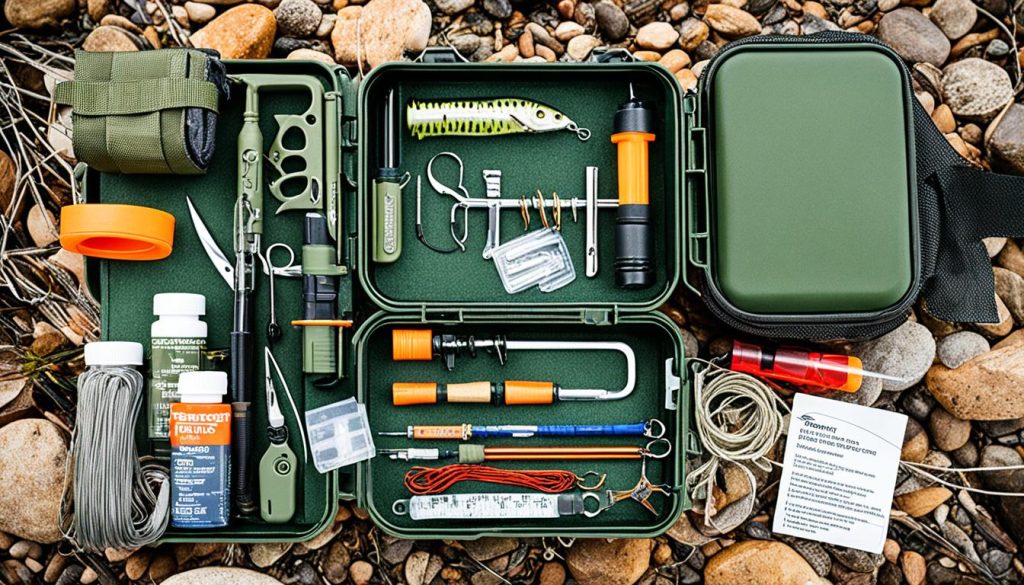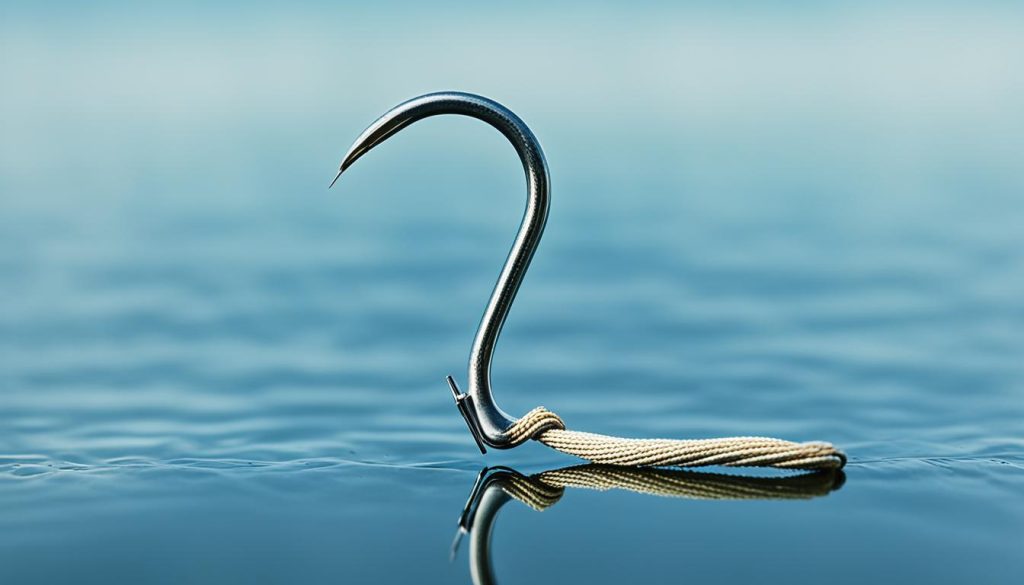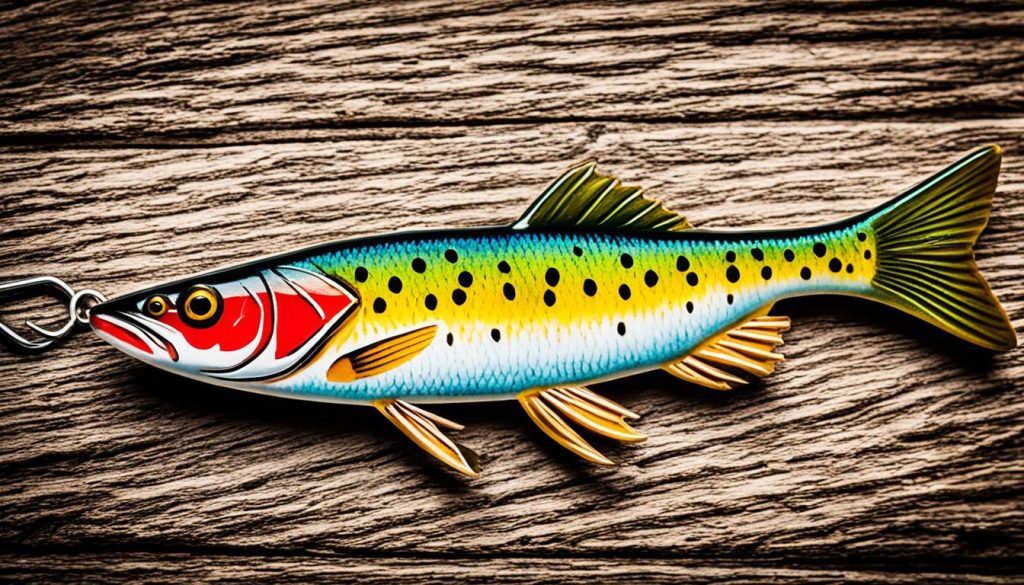Did you know that survival fishing can be a vital skill in emergency situations, providing a reliable source of food when other options are scarce? Whether you find yourself stranded in the wild or facing a crisis, knowing how to catch fish can make a significant difference in your survival. In this ultimate guide to survival fishing techniques, I will share expert advice and practical tips to help you become proficient in this essential skill.
Key Takeaways:
- Survival fishing is a crucial skill that can provide food in emergency situations.
- This guide will equip you with expert advice and practical tips for mastering survival fishing techniques.
- Understanding the right gear and techniques is essential for successful survival fishing.
- Choosing the right bait and location can greatly improve your chances of catching fish.
- Remember to practice responsible angling and respect the environment during survival fishing.
Setting Up Your Survival Fishing Kit
When it comes to survival fishing, having the right gear is crucial. Your survival fishing kit should be compact, lightweight, and easy to transport. Here are the essential items to include:
- A fishing rod: Choose a collapsible or telescopic fishing rod that can be easily packed in your backpack.
- A fishing reel: Opt for a small, durable reel that can handle different fishing conditions.
- Fishing line: Carry a spool of high-quality fishing line with a test strength suitable for the type of fish you intend to catch.
- Fishing hooks: Pack a variety of fishing hooks in different sizes to increase your chances of success.
- Sinkers: Sinkers are crucial for casting your bait deeper into the water. Include a few different sizes to adjust for varying water conditions.
- Swivels: Swivels are essential for preventing your line from tangling. They allow the line to rotate freely, minimizing twists and knots.
By having a well-equipped survival fishing kit, you’ll be prepared for a variety of fishing situations and increase your chances of catching fish even in challenging conditions.
| Item | Description |
|---|---|
| Fishing Rod | A collapsible or telescopic fishing rod that is lightweight and easy to carry |
| Fishing Reel | A small, durable reel that can handle different fishing conditions |
| Fishing Line | A spool of high-quality fishing line with a suitable test strength |
| Fishing Hooks | A variety of fishing hooks in different sizes |
| Sinkers | Assorted sinkers in various sizes for depth adjustment |
| Swivels | Swivels for line stabilization and prevention of tangles |
Prepping Your Fishing Line
Before heading out to fish, it’s crucial to prepare your fishing line properly. Ensuring that your fishing line is in good condition and securely attached to your fishing hook can significantly enhance your chances of success. Here are the essential steps to prepping your fishing line:
- Inspect your fishing line: Before every fishing trip, carefully examine your fishing line for any signs of wear or damage. Look for frays, knots, or weak spots that could compromise its strength. If you notice any issues, it’s best to replace the line to avoid unexpected breakages while fishing.
- Select your fishing hook: Choose a fishing hook that is appropriate for your target fish species and the fishing method you plan to use. Whether you prefer a single hook or a treble hook, ensure that it is sharp and free from rust or corrosion. A sharp hook increases your chances of hooking and landing fish successfully.
- Tie a secure knot: To attach the fishing hook to your line, it’s crucial to use a secure knot that will withstand the tension of a fish’s bite and the subsequent fight. One popular and reliable knot for this purpose is the improved clinch knot.
The improved clinch knot is easy to tie and provides excellent strength and reliability. Follow these steps to tie an improved clinch knot:
- Pass the end of the fishing line through the eye of the hook, ensuring you have enough line to work with.
- Twist the tag end of the line around the main line for five to seven turns.
- Pass the tag end of the line through the loop created just above the eye of the hook.
- Hold both the tag end and the main line and moisten them with water or saliva to lubricate the knot.
- Slowly tighten the knot by pulling the tag end while applying steady pressure to the hook. Ensure that the coils are tightly wrapped and evenly spaced.
- Trim any excess line, leaving a small tag to prevent slippage.
The improved clinch knot is a reliable and secure method for attaching your fishing hook to the line, even in challenging situations. Mastering this knot will give you confidence in its ability to withstand the force of a fish’s strikes and ensure your fishing line remains connected to your hook throughout your fishing expedition.
Now that your fishing line is prepped and ready, you’re one step closer to a successful fishing experience. The next section will delve into selecting the best bait to maximize your chances of enticing fish to bite.
Selecting the Best Bait
Choosing the right bait is crucial for a successful survival fishing expedition. In order to attract fish effectively, consider using a variety of bait options. If you have access to live bait, such as insects or small aquatic creatures, they can be highly effective in luring fish. Live bait mimics the natural food source of fish, increasing your chances of a catch.
However, in situations where live bait is scarce, it is important to adapt and improvise. Soft bits of food, such as small pieces of bread or cheese, can be used as an alternative. These serve as enticing options for fish, appealing to their sense of smell and taste.
Another option is to use reflective objects as bait. Fish are naturally attracted to shiny or glittery objects, as they resemble small fish or other prey. By attaching reflective objects, such as small pieces of foil or shiny materials, to your fishing line, you can increase your chances of attracting fish.
Key Points:
- Live bait, such as insects or small aquatic creatures, is a highly effective option for survival fishing.
- When live bait is scarce, improvising with soft bits of food can also attract fish.
- Reflective objects, like pieces of foil, can be used to mimic the appearance of small fish or prey and entice fish.
Remember, the success of your survival fishing trip heavily relies on the bait you choose. Experiment with different types of bait to determine what works best for the fish in your area and adapt accordingly. By selecting the right bait, you increase your chances of a fruitful fishing expedition even in challenging circumstances.
Building Basic Fishing Tools
In survival situations where you may not have access to fishing gear, it’s important to know how to create basic tools. With some ingenuity, you can fashion makeshift fishing tools using natural materials found in your surroundings.
Crafting a Makeshift Fishing Pole
To create a makeshift fishing pole, start by finding a sturdy branch that is approximately 10-12 feet long. Look for a branch that has some flexibility but is not too brittle. Strip off any smaller branches or leaves.
Next, attach your fishing line to one end of the branch. Tie the line securely using a reliable knot like the improved clinch knot. Ensure the line is tightly fastened to the pole to prevent it from coming loose during casting or reeling in.
Once your fishing line is attached, you’re ready to start fishing! Use your makeshift fishing pole just as you would a regular fishing rod, casting your line into the water and waiting for a bite.
Creating Fishing Hooks from Natural Materials
If you don’t have fishing hooks on hand, you can fashion your own using natural materials. Look for plant stems or thorns that are sturdy and sharp.
To create a fishing hook, carefully shape the stem or thorn into a hook shape using a knife or sharp rock. Make sure the point is sharp enough to penetrate a fish’s mouth but be cautious while handling the sharp object.
Attach your homemade fishing hook to the end of your fishing line using a secure knot. Similar to the improved clinch knot, ensure the knot is tight and won’t come undone while you’re reeling in a catch.
Constructing a Simple Fishing Net
In addition to a fishing pole and hooks, a fishing net can significantly increase your chances of catching fish. To create a basic fishing net, gather long, flexible branches to serve as the frame.
Interweave vines or long grasses between the branches, closely overlapping them to create a mesh-like structure. The net should be of a suitable size to effectively capture fish but not so large that they can easily escape.
When using the net, carefully lower it into the water and wait for fish to swim into its meshes. Once a fish is trapped, quickly lift the net out of the water to secure your catch.
With these simple DIY fishing tools, you can increase your chances of survival in a fishing emergency. Remember to practice caution while handling sharp or potentially dangerous objects and always be mindful of your surroundings.
Locating the Ideal Fishing Spot
When it comes to successful fishing, finding the ideal fishing spot is key. Understanding fish activity, underwater structures, fish behavior, safety, and accessibility are all essential factors to consider. Let’s explore these elements in detail to help you locate the perfect spot for a fruitful fishing experience.
Fish Activity
Observing fish activity is a telltale sign of a promising fishing spot. Keep an eye out for jumping fish or swirling water, as these indicate active feeding patterns. These areas are often teeming with fish and present a great opportunity for a successful catch.
Underwater Structures
Identifying underwater structures is crucial as they serve as hiding spots and feeding grounds for fish. Fallen trees, submerged rocks, or dense vegetation provide shelter and attract fish looking for food and protection. These structures act as natural fish magnets, making them ideal spots for casting your line.
Fish Behavior
Understanding fish behavior is essential for choosing the right fishing spot. Different fish species have distinct preferences when it comes to habitat and feeding patterns. Some fish prefer shallow waters near the shore, while others venture into deeper areas. Research the behavior of the fish species in your area to identify their preferred locations.
Safety and Accessibility
While scouting for fishing spots, safety should always be a priority. Look for spots that are easily accessible, minimizing the risk of accidents or injuries. Ensure you have permission to fish in the area and adhere to any local regulations or restrictions. Also, consider factors such as weather conditions and potential hazards like strong currents or unstable banks.
Taking these factors into account will greatly increase your chances of finding the ideal fishing spot. Remember, thorough research, careful observation, and understanding fish behavior will guide you to the areas where fish are plentiful and ready to take a bite.
Conclusion
Mastering survival fishing techniques is essential for anyone venturing into the wilderness. Whether you find yourself in an emergency situation or simply enjoy the thrill of testing your skills, knowing how to catch fish can make a world of difference. From setting up your fishing kit to understanding different fishing techniques, these skills can provide you with a valuable source of food when resources are scarce.
Responsible angling is also a crucial aspect of survival fishing. By practicing catch-and-release practices and respecting the environment, we can ensure the sustainability of fish populations and preserve the beauty of our natural surroundings. Remember to follow local regulations and guidelines to protect the ecosystem and leave no trace of your presence.
With the right knowledge and skills, survival fishing can be a rewarding and fulfilling experience. It allows you to connect with nature, test your resourcefulness, and provide for yourself and your loved ones when circumstances dictate. So, whether you’re a seasoned angler or new to the world of fishing, continue to learn, adapt, and explore the art of survival fishing.



